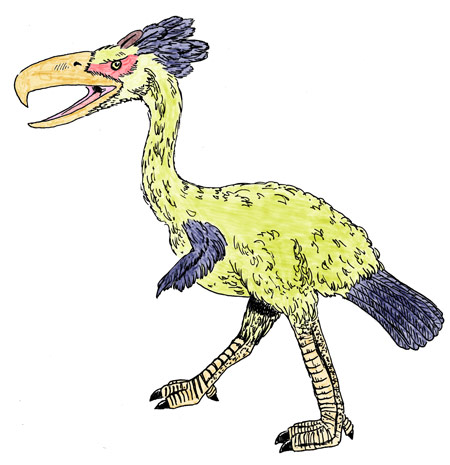Newly published research studying bird evolution suggests a link between complex skeletons and reduced biodiversity. As birds develop more complex anatomies, they also decrease in diversity, with fewer species as they become more specialised within specific ecological niches.

Picture credit: Everything Dinosaur
Studying Patterns in Bird Evolution
Researchers at the Milner Centre for Evolution at the University of Bath collaborated with colleagues at the University of Lincoln, University College London and the Chinese Academy of Sciences. Their findings have been published in the journal “Nature Communications”.
The team looked at 983 species across all major groups of living birds and measured the complexity of their skeletons by comparing the bones in their fore limbs (wings) and hind limbs (legs).
They found that less complex birds – those with a smaller differences between their fore and hind limbs – had more species diversity than those with higher complexity and a larger difference between their limbs.
As an example, birds such as pigeons, gulls and songbirds (passerines) have low skeletal complexity but a high diversity of species living in varied habitats across the world.
At the other end of the spectrum, flamingos, and ostriches have short wings in comparison to their legs, and so have more complex limb skeletons. Groups with more complex skeletons may occupy smaller niches and are less able to subdivide those niche spaces in order to produce new species.
Trapped in an Ecological Niche
Whilst evolution can produce forms with lower complexity, these findings suggest that birds with more complex skeletons have become more specialised over time and so more developmentally entrenched. This may make them less likely to evolve back to become simpler again. In essence, Aves with complex skeletons may find themselves trapped within a specific ecological niche.

Picture credit: Everything Dinosaur
Causes of Biodiversity
Professor Matthew Wills, (Milner Centre for Evolution at the University of Bath) explained:
“We wanted to understand what causes some groups of birds to be species rich and others to be species poor – although ecology obviously plays an important part, it doesn’t account for the huge differences we see in biodiversity.”
Professor Wills added:
“The received wisdom is that there is no direction to evolution – that selection can act in any direction. Our study suggests that, in birds at least, the more they specialise, the less they are able to give rise to new species.”
A Case of Putting All Your Eggs in One Basket
The scientists also found that birds with more complex skeletons were generally more ecologically specialised, occupying fewer habitats and foraging for food in less varied ways.
Lead author of the paper, PhD student Andrew Brinkworth (Milner Centre for Evolution at the University of Bath) stated:
“Species can evolve to be specialised, and fill very small niches. However, in doing so, they restrict the number of routes they can evolve further, meaning they are likely to be less resilient to changes in the environment such as those caused by habitat loss, disruption to food chains and climate change.”
Andrew added:
“From our findings we predict that birds with more complex skeletons and less diversity will be at greater risk of extinction from these changes.”
Wider Implications for Bird Evolution and Animal Life
The researchers intend to broaden their research to see if this pattern is repeated in other animal groups. It would be interesting to see if this relationship between complex skeletons and reduced biodiversity can be identified in extinct groups, including theropod dinosaurs.
Could such a pattern be identified in the Theropoda to bird evolution lineage?
Everything Dinosaur acknowledges the assistance of media release from the University of Bath in the compilation of this article.
The scientific paper: “Bird clades with less complex appendicular skeletons tend to have higher species richness” by Andrew Brinkworth, Emily Green, Yimeng Li, Jack Oyston, Marcello Ruta, Matthew A. Wills published in Nature Communications.
Visit the Everything Dinosaur website: Everything Dinosaur.






Leave A Comment